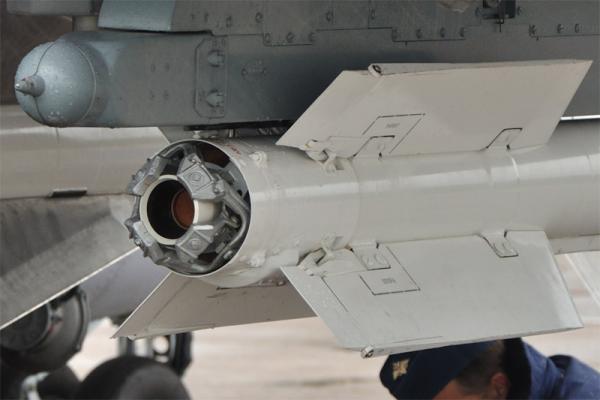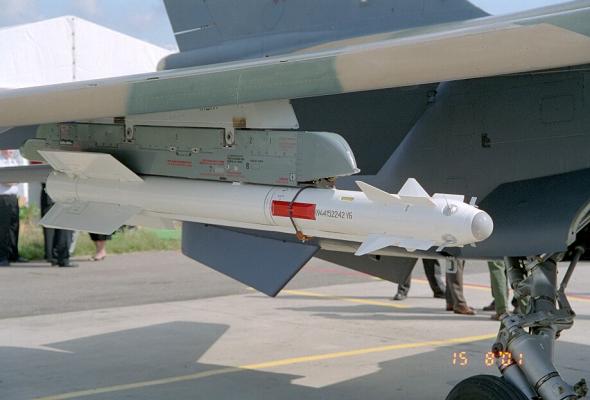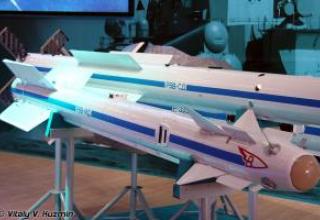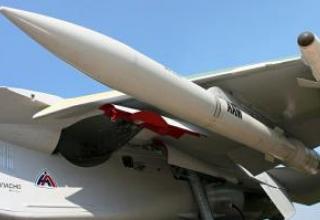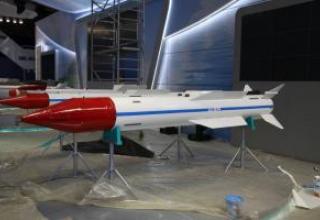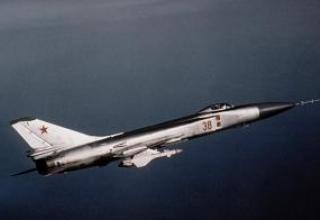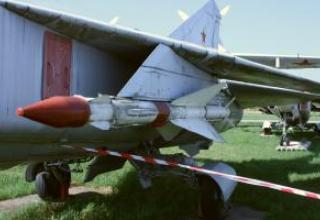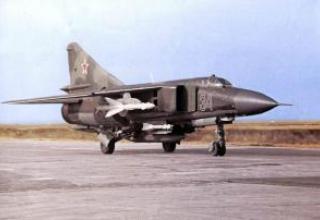Short range R-73 missile with homing head is designed to intercept and destroy in close air battles highly maneuverable manned and unmanned enemy vehicles day and night, from any direction, in the front and rear hemispheres, on the ground and with active radioelectronic counteraction. The design of the R-73 missile meets the close combat characteristics of modern fighters. Automatic drifting balloons, cruise missiles and helicopters can be hit.
The missile was developed by NPO Lightning (since 1983, the State Design Bureau Vympel has been developing and upgrading the R-73) and adopted for service in 1983. It is equipped with all modifications of the MiG-29 and Su-27 frontline fighters, Su-34 frontline bombers and Su-25TM (Su-39) attack aircraft. The export version of the missile is called R-73E.
At present, there are two versions of this missile: R-73 RMD-1 and R-73M RMD-2, differing mainly in their target designation angles: 45° for the RMD-1 version and 60° for the RMD-2 version. In addition to increasing the target designation angles, the RMD-2 homing head has increased noise immunity against infrared countermeasures and is built on a digital element base, which allows easy reprogramming of tracking and interception algorithms. The capabilities of attacking low-flying targets have been improved. R-73 RMD-2 can serve for the organization of missile defense and allows to implement a reverse start mode for the defense of the rear hemisphere of the carrier.
NATO Identification AA-11 "Archer".
Composition:
The rocket, made according to the aerodynamic scheme "duck" (see projections) with destabilizers in the head part of the hull and the traditional cross-shaped arrangement of aerodynamic surfaces on the nozzle part of the engine, is installed gas-dynamic control unit interceptor type, creating a lateral force due to the deviation of the engine gas jet, which gives the rocket high maneuverability. The destabilizers (see photo) are located in front of the rudders and, in addition to their traditional purpose, reduce local attack angles, protecting the steering surfaces from flow disruptions and efficiency drops during sharp maneuvers. When the engine is running, control and stabilization of the rocket on the pitch and course are jointly connected in pairs for each channel four aerodynamic rudders and four gas-dynamic interceptors. After the engine is running, only the aerodynamic rudders control and stabilization. The stabilization of the rocket on the heel is carried out using four mechanically connected ailerons.
Gas Dynamic Control provides high maneuverability immediately after launch, when the speed is not yet high and the efficiency of conventional rudders is insufficient. The jet deflection allows the missile to change its flight direction by 90° or more. The P-73 practically does not impose restrictions on the launch conditions and maneuvers of the launch vehicle. High controllability and supermaneuverability of the R-73 allows it to attack targets flying at altitudes from 5m with overloads up to 12g not only on the catch-up, but also on the meeting and intersecting courses, attacking them on the optimal "broken" trajectories almost without bending radii with their own overloads to 40g. The 7700N thrust engine gives the missile a high energy output, so it can also be launched into the rear hemisphere for carrier defense. This method of "reverse launch" was tested and proved to be effective, and the development of advanced Soviet fighters included the installation of an additional radar for search and target designation in the rear hemisphere. Translated with www.DeepL.com/Translator (free version)
The R-73 autopilot uses information from fountain sensors of angles of attack and sliding, placed in front of the destabilizers and the volume of operations performed is comparable to an aircraft SAU. The complex of fountain sensors, destabilizers and rudders forms a characteristic "herringbone" in the first compartment of the missile - CNS. Aerodynamic rudders with paired aerodynamic communication are used by the steering machines placed in the front of the second compartment, behind which are located blocks of autopilot and active radio. The third compartment is occupied by a solid fuel gas generator with increased capacity. The working body produced by it goes to the steering machines of aerodynamic rudders and through the gas pipeline passing through the gargrot - to the rockets located in the tail compartment of the steering machines interceptors and ailerons. The fourth compartment is a combat unit, inside which the PIM is placed. The kill radius of the combat unit is about 3.5m. The detonator is radar. The R-73L and R-73EL modifications are equipped with an optical laser fuse (see photo). The fifth compartment is a single-mode solid propellant rocket motor. The tail compartment of the engine is equipped with steering machines for aileron drive and gas-dynamic interceptors.
P-73 is equipped with a small-size passive infrared homing head of high sensitivity and interference immunity with deep cooling of the photoreceiver, which captures the target in the suspension under the carrier. This head works out angles of target designation up to 45° (60° for RMD-2), has pumping angles of coordinator up to 75° and angular speed of target tracking (angular speed of sighting line) up to 60°/s. To save the pilot from wasting time on the choice of short- or medium-range weapons in a rapidly changing combat environment, the permitted launch distance of the R-73 is increased to 30 km (RMD2 to 40 km). The CNS allows for adjustment from natural and artificial interferences by means of digital signal processing. The missile attacks a target flying in the altitude range from 20m (5m for the R-73M RMD-2) to 20km at a speed of up to 2,500 km/h at any initial position. Target designation can be obtained from any information sources: radar or optoelectronic sighting system, helmet-mounted target designation system, etc., which allows further upgrades to increase range, interference immunity and efficiency.
The main elements of the rocket, except for the steel engine housing, are made of aluminium alloys. The compartments are joined by a bayonet joint, except for the end compartments which are joined by means of flanged joints. A fully assembled missile is delivered to the troops in hermetically sealed and wooden capping.
Depending on the modification, the missile is equipped with a laser or radio detonator. The combat unit weighs 7.4 kg (BB mass - 2.45 kg) of rod type. The striking elements of the BC are massive uranium rods.
The training version of the missile with a record recorder is called UZR-73, the export version of the missile - R-73E. There was also developed a variant of R-73M, equipped with SOS with multi-site dual-band photoreceiver of increased interference immunity with twice the sensitivity and range of capture. The R-73M target designation area has been extended to +90°, and to increase its striking effect the autopilot directs it from the engine torch to the central part of the aircraft when approaching the target. R-73 is one of the world's first short-range missiles capable of hitting targets not only on overtaking, but also on intercepting courses. The missile attacks the target at any initial position, allows to intercept targets flying in a wide range of altitudes and speeds. To increase the probability of hitting targets on overlapping courses, the homing head shifts the homing point from the nozzle to the target's fuselage.
The main material of the design is aluminum alloys, while the engine housing is steel.
For the suspension under the carriers and the launch of the missile used rail launcher P-72 - with a sequential output of three rods from the rails; suspension units to the aircraft - ear type. Placed in this device equipment provides the possibility of missile application from any modern aircraft without its significant improvement. According to other data, the suspension of missiles R-73 is made on aircraft launchers ACU-73, installed on the outer wing points of the suspension.
According to the level of basic tactical and technical characteristics that determine the effectiveness of missiles in close air battles (maximum overload of targets, angles of target designation, the angular speed of target auto tracking head homing, the minimum range of launch on maneuvering targets), R-73 missile superior to the best foreign counterparts.
Characteristics:
| Carriers |
MiG-21-93, MiG-23ML, MiG-29, MiG-29C, MiG-29K, Su-27, Su-25T, Yak-141, Ka-52. |
| Starter weight, kg | |
| RMD-1 | 105 |
| RMD-2 | 110 |
| Weight of combat unit, kg | 7.4 |
| Start range, km | |
| - minimum | 0.3 |
| - maximum for RMD-1 | 20 |
| - maximum for RMD-2 | 40 |
| Overloading of affected targets | 12 |
| Own permissible missile overload | 40 |
| Probability of hitting the target | 0,6 |
| Length, mm | 2900 |
| Body diameter, mm | 170 |
| Finger scale, mm | 510 |
Testing:
R-3C was baptized in battle in Vietnam and then in the Middle East. It proved to be a good weapon, unpretentious and reliable. However, TGSN R-3S was sensitive to weather conditions (rain and cloud cover absorbed infrared radiation), the attack was possible only from the rear hemisphere, and to evade it, the enemy used to evade the sun - a powerful natural source of heat (at night such a false target could be a "cold" moon). The launch performance was also affected by the missile's limited maneuverability when flying to the target, its inability to descend from the track at high overloads in combat and insufficiently powerful combat unit. The area of possible attacks was also reduced by the minimum allowed range (it was determined by the inability of the TGSN to track the target moving fast on azimuth and its own safety in case of a BC explosion).
For 1966. - the first year of use of R-ZS missiles in Vietnam, they were hit by 16 out of 57 American aircraft shot down by fighter aircraft. Their efficiency was 35% at 46 launches. Skills and more careful observance of tactical recommendations allowed next year to increase the effectiveness of missile attacks: in 53 battles MiG-21 shot down 50 planes. The overwhelming majority of R-3C launches were carried out from behind at short ranges (1200 - 2500m), only 5% of the attacks were carried out from distances over 2500m.
Shortcomings in training and tactics affected the use of missiles in the Middle East battles: sharp maneuvers of impulsive Arab pilots who did not comply with the prescribed modes of launch, led to unsuccessful launches and wasted missiles. Thus, in the group battle on November 3, 1968, the price of victory over two Israeli "Mirages" was 13 spent by the Egyptians R-3C. In the Indo-Pakistan conflict in December 1971, out of 10 victories won by Indian MiG-21, 8 were achieved with the use of guns and only 2 with the launch of R-3C.
Sources:
- "Военный парад". Сентябрь-октябрь 1998.
- "Независимое военное обозрение". 1998
- Russian Air-to-Air Missile AA-11 (Archer)
- Molniya/Vympel R-73 (AA-11 Archer)
- http://pfc-joker.livejournal.com/

